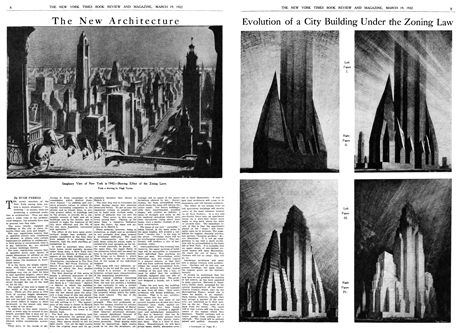The Skyscraper Museum is devoted to the study of high-rise building, past, present, and future. The Museum explores tall buildings as objects of design, products of technology, sites of construction, investments in real estate, and places of work and residence. This site will look better in a browser that supports web standards, but it is accessible to any browser or Internet device.

1916 Zoning Laws

Hugh Ferriss, "The New Architecture," The New York Times Magazine, March 19, 1922, p. 8-9
The Hugh Ferriss drawings of 1922, known as "The Four Stages" or "Evolution of the Set-back Building" are perhaps the most iconic and influential architectural images of the 1920s. Widely exhibited and published, they inspired other architects to understand the rules of New York's 1916 zoning law, not as a restriction, but as a form-giving principle for a new, modern skyscraper.
Conceived in collaboration with the architect Harvey Wiley Corbett in 1916, the drawings illustrate the step-by-step shaping of the maximum mass allowed by the zoning law into a profitable commercial structure. The first stage was described as "simply a pictorial statement of the law in perspective," with sloping planes representing the angle of light required to preserve some sunlight on the streets and with a tower that filled the allowable one-quarter of the site.

The power and inchoate modernity of Ferriss's diagrams derived from their simple sculptural mass and monumentality. "Imagine," he wrote, "that the law placed upon the property a huge mass of clay and stated: "Your building must be built of this clay: remove as much as you want, but add nothing to it." The resulting form suggested a new solution for high-rise design. "The law demolishes the box and produces a pyramid which must be sculpted in three dimensions."